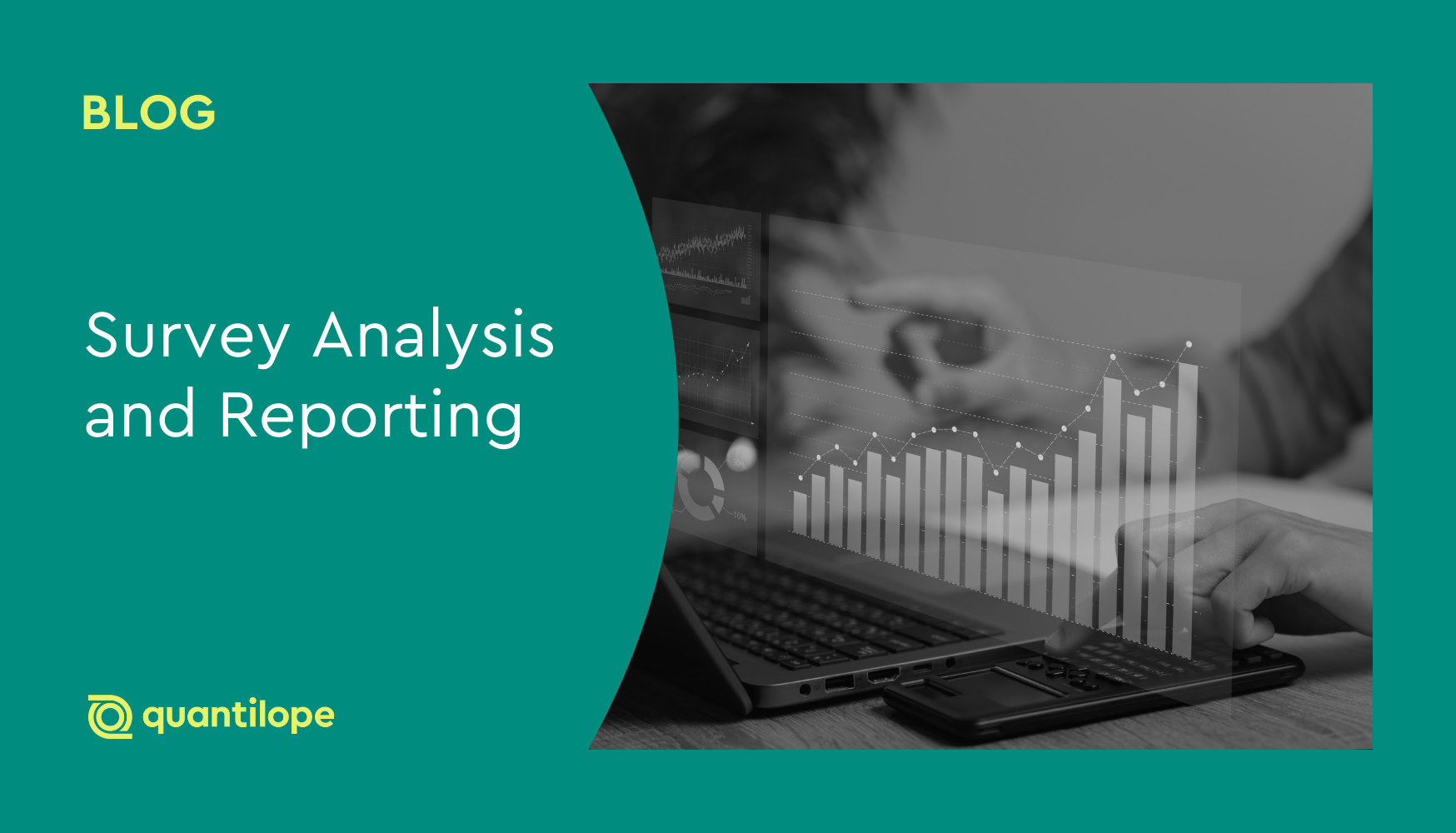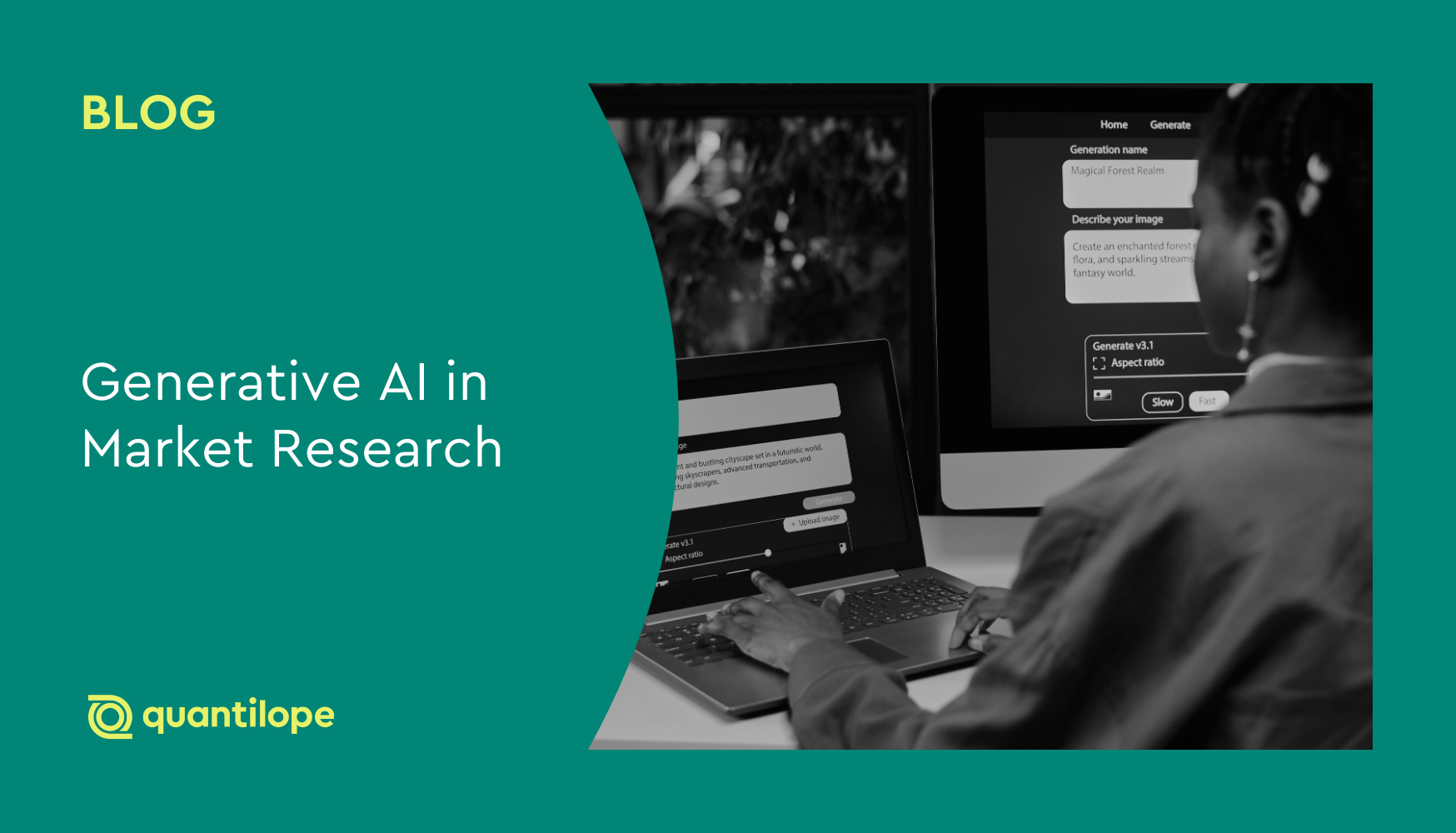In this blog, learn how to effectively analyze survey data and report on findings that portray an actionable insights story for key stakeholders.
Table of Contents:
- How to analyze survey results
- How to present survey results
- How to write a survey report
- Common mistakes in analyzing survey results
- Best practices for presenting survey results
-
How quantilope streamlines the analysis and presentation of survey results
How to analyze survey results
Analyzing survey results can feel overwhelming, with so many variables to dig into when looking to pull out the most actionable, interesting consumer stories. Below we’ll walk through how to make the most of your survey data through a thorough yet efficient analysis process.
Review your top survey questions
Begin your data analysis by identifying the key survey questions in your questionnaire that align with your broader market research questions or business objectives. These are the questions that most closely relate to what you’re trying to achieve with your research project and the ones you should focus on the most.
Other variables throughout your survey are important - but they may be better leveraged as cross-analysis variables (i.e. variables you filter down major questions by) rather than ones to be analyzed independently. Which brings us to our next step...
Analyze and cross-analyze your quantitative data
Quantitative survey questions provide numerical information that can be statistically analyzed. Start by examining top-level numerical responses in your quantitative data (ratings, rankings, frequencies) for your most strategic survey questions. Think about which variables might tell an even richer and more meaningful story when cut by subgroups (i.e cross-tabulation)- such as looking into buying behavior, cut by a demographic variable (gender, age, etc). This deeper level of analysis uncovers insights from survey respondents that may not have been as apparent when examining survey variables in isolation.
Take your time during this step to explore your data and identify interesting stories that you’ll eventually want to use in a final report. This is the fun part! At least us at quantilope think so...
Consider statistical analysis
Next, run statistical analysis on relevant questions. Traditional agencies typically require the help from a behavioral science/data processing team for this, but many automated platforms (like quantilope) can run statistical analysis without any manual effort required.
Statistical significance testing provides an added layer of validity to your data, giving stakeholders even more confidence in the recommendations you’re making. Knowing which data points are significantly stronger/weaker than others confirms where you can have the most confidence in your data.
How to present survey results
Data is a powerful tool, but it's only valuable if your audience can grasp its meaning. Visual representations of your quantitative data can offer insights into patterns or trends that you may have missed when looking strictly at the numbers and they offer a clear, compelling way to present your findings to others.
Data visualization can sometimes be done while you’re analyzing and cross-analyzing your data (if using an automated platform like quantilope). Otherwise, this is the step in your insights process when you’ll take the findings you found during the analysis stage and give them life through intuitive charts and graphs.
Below are a few steps to clearly visualize insights once you collect data:
Choose your chart types:
The first step is to select the right chart type for your data based on the type of question asked. No one chart fits all types of data. Choose a chart that clearly displays each of your data points’ stories in the most appropriate way.
Below are a few commonly used chart types in market research:
-
Column/bar graphs: Great for comparing categories.
-
Line charts: Show trends and changes over time compared to an initial benchmark (great for a brand tracking survey).
-
Pie charts: Used to display parts of a whole.
-
Scatter plots: Visualize the relationship between two variables (used in a Key Driver Analysis!).
-
Word clouds: Good for concise open-ended responses (i.e. brand names) to see which words appear biggest/smallest (representing the volume of feedback, respectively).
The right chart type will clearly display meaningful patterns and insights. quantilope’s platform makes it easy to toggle between different chart types and choose the one that best represents your data - significance testing already included!
Leverage numerical tables:
Sometimes, nothing beats the precision and detail of a well-structured numerical table. When you need to provide exact values or compare specific data points, numerical tables are your go-to.
When using numerical tables to present your findings, make sure they are:
-
Clear: Use explanatory headings and proper, consistent formatting.
-
Concise: Present only the essential data without unnecessary clutter.
How to write a survey report
Lastly, take your data analysis - complete with chart visualizations and statistical analyses, and build a final report such as a slide report deck or an interactive dashboard.
This is where you’ll want to put your strategic thinking hat on to determine which charts, headlines, graphics, etc., are going to be most compelling/interesting to final stakeholders and key decision makers; them buying into your data is not done purely on the data itself, rather how you organize and present it.
Below are a few considerations when building and writing your final survey report:
Start with methodology:
Start by clearly describing how you designed and administered your survey to respondents.
Include details like:
-
Sampling methods: How were participants selected (random, convenience, representative)
-
Sample size: How many people participated in your study?
-
Sampling timeframe: When did your study run?
-
Survey format: Where did you administer your survey? (online, phone, in-person, etc.)
-
Question types: Multiple choice, open-ended questions, likert scales, and so on.
-
Advanced methods: Did you leverage any advanced methodologies beyond standard usage and attitude questions such as NPS (net promoter score) for customer satisfaction or a segmentation for need-based customer feedback?
Your methodology background knowledge is helpful to those reading your report for added context and credibility. You can also use this section of your report to define any complex methodologies used in your study that might require added explanation to readers without a market research background.
Craft a story:
Don't make the mistake of throwing data points at your audience. Part of reporting on your online surveys includes crafting narratives that tie your data findings together to sell your story to your audience. What patterns emerge? Are there any surprises? Embed these stories into your charts through headlines and chart descriptions, and tie them back to your research objectives whenever possible.
Think carefully about the following when crafting your data story:
-
The big takeaway: What's the core message you want to convey?
-
Context: Why does this story matter in the greater scheme of your business?
-
Implications: What business decisions or stakeholder actions might come from these findings?
Organize your findings logically by themes or question categories, and include a summary/final takeaway at the end for readers who want a very quick and digestible understanding of your study. Your story is what stakeholders and key decision makers look for in market research - it’s your chance to impress them and ensure your data findings generate real impact.
Incorporate infographics and other visual stimuli:
Aside from data charts, other visual stimuli add richness to your data presentation, making it more digestible and memorable.
Consider these added visuals when presenting your data:
-
Infographics: Summarize key findings with icons, charts, and text.
-
Images: Add relatable pictures that resonate with your data and/or audience.
-
Color: Use color strategically to emphasize crucial points or to emulate a brand’s look/feel.
-
Qualitative data: Include insightful quotes or video responses (if applicable) to add additional stories, trends, or opinions to your report.
Common mistakes in analyzing survey results
Analyzing, presenting, and reporting on survey findings isn’t difficult when using the right tools and following the above best practices.
However, there are some things to keep in mind during these processes to avoid some common mistakes:
Biases
Avoid biased results in your final survey analysis and presentation by controlling for things like sampling bias and reporting bias. Sampling bias occurs when you don’t use a truly representative sample of your target population; this can skew your results and portray inaccurate/misleadings findings. Reporting bias occurs when you don’t account for personal biases in what you choose to share (i.e. cherry picking the data that seems the most positive or that supports your personal pre-existing idea - often referred to as confirmation bias). Avoid survey biases by having a second (or even third) colleague review your work at each stage before sharing it with final stakeholders.
Misinterpreting correlation as causation
Just because two variables are related doesn't mean one causes the other. Be cautious about drawing causal conclusions without strong supporting evidence. The only real way to determine causation is through a specialized statistical analysis like regression analysis.
Looking into every data point
Surveys produce a lot of really valuable information, but you need to focus your attention on the metrics that generate impact for your research objective. It’s easy to get lost in an excel data file or research platform when trying to look through every survey response cut by as many variables as you can think of.
Start your analysis by strategically thinking about your research as a whole. What were you hoping to find out from your study? Start there. Once you start exploring your major metrics, a story might naturally arise that leads you to further data cuts. Your data analysis should be comprehensive, yet efficient.
Best practices for presenting survey results
While the above elements are things you’ll want to avoid in your research analysis, here are some a survey best practices you’ll want to keep in mind:
Know your audience
Tailor your report/presentation to your specific audience’s needs and understanding level. This might even mean creating different versions of your report that are geared toward different audiences. Some stakeholders might be very technical and are looking for all the small details while others just want the bare minimum overview.
Keep it simple
Charts and graphs should make data easier to understand, not more confusing. Avoid using too many chart types or overwhelming viewers with too much information. What are the charts that absolutely must be included to tell your full consumer story, and which are ‘nice to have’ if you had to pick and choose? Your final report doesn’t need to (and shouldn’t) house every possible data point and data cut from your study. That’s what your raw data file is for - and you can always go back to reference this when needed. Your report however is the main takeaway and summary of your study; it should be concise and to the point.
Provide enough information for your audience to understand how you reached your conclusions, but avoid burying them in irrelevant details. Any ‘extra’ data that you want to include but that doesn’t need to be front and center in your report can be included in an accompanying appendix.
Communicate clearly
Don't make your audience struggle to decode your visuals. Each chart should have a very clear takeaway that a reader of any skillset can digest almost instantly. More complex charts should have clear headlines or interpretation notes, written in simple language for your audience (non-technical or specialized terms).
Back to table of contents
How quantilope streamlines the analysis and presentation of survey results
quantilope’s automated Consumer Intelligence Platform saves clients from the tedious, manual processes of traditional market research, offering an end-to-end resource for questionnaire setup, real-time fielding, automated charting, and AI-assisted reporting.
From the start, work with your dedicated team of research consultants (or do it on your own through a DIY platform approach) to start building a questionnaire with the simple drag and drop of U&A questions and advanced methods. Should you wish to streamline things even further, get a head start by leveraging a number of survey templates and customize as needed.
quantilope’s platform offers all types of surveys - such as concept testing, ad effectiveness, and Better Brand Health Tracking to name a few. Available for use in these surveys is quantilope’s largest suite of automated advanced methods, making even the most complex methodologies available to researchers of any background.
As soon as respondents begin to complete your survey, monitor response rates directly in the fielding tab - right at your fingertips. Get a jump start on survey data analysis as soon as you like, rather than waiting for fieldwork to close and to receive data files from a data processing team. Lean on quantilope’s AI co-pilot, quinn, to generate inspiration for chart headlines and report summaries/takeaways.
With quantilope, researchers have hands-on control of their survey analysis and reporting processes, for the opportunity to make clear business recommendations based on actionable insights.
Interested in learning more about quantilope’s Consumer Intelligence Platform? Get in touch below!



.png)
